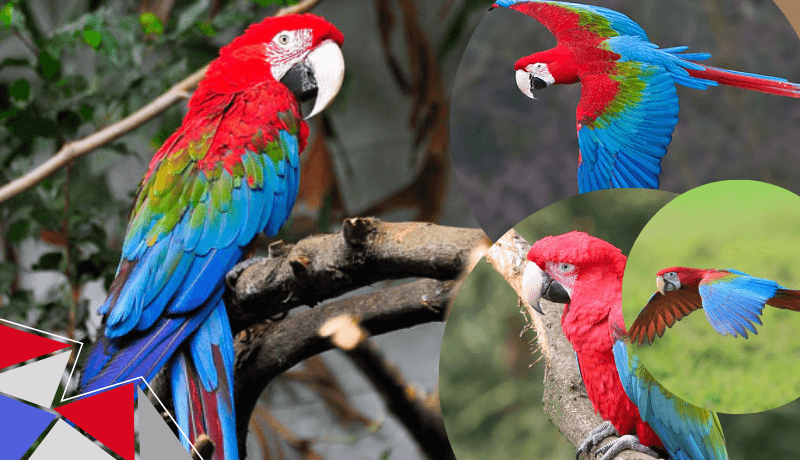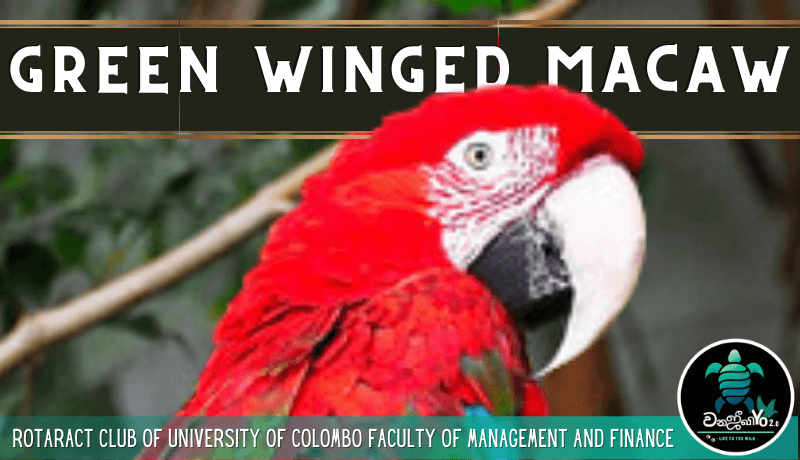General
Green Winged Macaw also referred to as the Red and Green Macaw, is a sizable member of the Ara genus and is primarily red. This gorgeous and recognizable parrot belongs to one of the biggest Macaw species.
Distribution and habitat
The geographic range of the Green Winged Macaw spans parts of Central and South America, from eastern Panama to Colombia, Venezuela, and the Guianas. It also includes the western portion of South America, from eastern Ecuador and eastern Peru to northern and eastern Bolivia. These birds’ natural habitats include lowlands, tropical rainforests, and foothills. They rarely occur in coastal areas and are mostly found in inland regions.
Appearance
The Green Winged Macaw has white skin with a white patch protecting its eyes, which are bordered by bright red bars consisting of rows of tiny feathers. The bird’s head, upper back, upper wings, and chest are all crimson. The bird’s legs are gray. The middle wing’s feathers are green with blue tips. With red feathers all around, the tail has a jumble of feathers. The bottom beak is black or dark gray, while the horn-colored top beak has black sides.
Habits and behavior
The gregarious Green Winged Macaw lives in pairs and congregates in small flocks or family groups with 6 to 12 other birds. However, these birds can occasionally be observed in even larger groups in feeding trees and at clay licks, mingling with other Macaws and generating a lot of noise with each bird displaying its complete vocal range. The majority of the day is spent by Green Winged Macaws in the dense rainforest, where they find shelter, socialize, and feed. They also spend a lot of time playing together and grooming each other’s feathers to eliminate ticks and lice. If you encounter three or four Macaws together, they are likely a pair with their young. These birds are very elusive in the undergrowth and are extremely shy. The bird immediately takes off while screeching loudly when it senses danger.
Threats
One of the main dangers to this species, which results in the loss of their native habitat, is deforestation. Due to its uneven coloring, the bird is frequently hunted by local tribes. This bird, along with others of its kind, has been taken for the pet trade. CITES II currently protects this Macaw, which forbids its capture and commerce. Last but not least, the Green Winged Macaw has become extinct in various areas of its historic range, including Argentina.

සාමාන්ය
හරිත පියාපත් සහිත මැකෝ, රතු සහ කොළ මැකෝ ලෙසද හැඳින්වේ. Ara කුලයට අයත් සැලකිය යුතු සාමාජිකයෙකු වන අතර මූලික වශයෙන් රතු වේ. මෙම අලංකාර සහ හඳුනාගත හැකි ගිරවා විශාලතම මැකෝ විශේෂයට අයත් වේ.
ව්යාප්තිය සහ වාසස්ථාන
මොවුන්ගේ භූගෝලීය පරාසය මධ්යම සහ දකුණු ඇමරිකාවේ කොටස්, නැගෙනහිර පැනමාවේ සිට කොලොම්බියාව, වෙනිසියුලාව සහ ගයනාස් දක්වා විහිදේ. නැගෙනහිර ඉක්වදෝරයේ සහ නැගෙනහිර පේරු සිට උතුරු සහ නැගෙනහිර බොලිවියාව දක්වා දකුණු ඇමරිකාවේ බටහිර කොටස ද එයට ඇතුළත් ය. මෙම පක්ෂීන්ගේ ස්වභාවික වාසස්ථාන පහත් බිම්, නිවර්තන වැසි වනාන්තර සහ කඳු පාමුල ඇතුළත් වේ. වෙරළබඩ ප්රදේශවල කලාතුරකින් දක්නට ලැබෙන අතර බොහෝ දුරට අභ්යන්තර ප්රදේශවල දක්නට ලැබේ.
පෙනුම
හරිත පියාපත් සහිත මැකෝට සුදු පැහැති සමක් ඇති අතර ඇස් ආරක්ෂා කරන සුදු පැල්ලමක් ඇති අතර ඒවා කුඩා පිහාටු පේළි වලින් සමන්විත දීප්තිමත් රතු තීරු වලින් මායිම් වේ. කුරුල්ලාගේ හිස, ඉහළ පිටුපස, ඉහළ පියාපත් සහ පපුව තද රතු පාටයි. කුරුල්ලාගේ කකුල් අළු පාටයි. මැද පියාපත් වල පිහාටු නිල් පැහැති ඉඟි සහිත කොළ පාටයි. වටේටම රතු පිහාටු ඇති, වලිගය පිහාටු පටලැවිල්ලක් ඇත. පහළ හොට කළු හෝ තද අළු වන අතර, අං පැහැති ඉහළ හොට කළු පැති ඇත.
පුරුදු සහ හැසිරීම
මොවුන් යුගල වශයෙන් ජීවත් වන අතර කුඩා රංචු හෝ පවුල් කණ්ඩායම් වශයෙන් තවත් පක්ෂීන් 6 සිට 12 දක්වා එක්රැස් වේ. කෙසේ වෙතත්, මෙම පක්ෂීන් විටින් විට ගස් පෝෂණය කිරීමේදී සහ මැටි ලෙවකන විට, අනෙකුත් මැකෝවරුන් සමඟ මිශ්ර වී විශාල කන්ඩායම් වන බව නිරීක්ෂණය කළ හැකිය. දවසේ වැඩි කාලයක් ඝන වැසි වනාන්තරවල ගත කරන අතර එහිදී ඔවුන් නවාතැන්, සමාජගත කිරීම සහ ආහාර ගැනීම කරති. කිනිතුල්ලන් සහ උකුණන් තුරන් කිරීම සඳහා ඔවුන් එකට සෙල්ලම් කරමින් එකිනෙකාගේ පිහාටු අලංකාර කරමින් බොහෝ කාලයක් ගත කරති. මැකාවෝ තුනක් හෝ හතරක් එකට හමු වුවහොත්, ඒ ඔවුන්ගේ පැටවුන් සමඟ කුරුලු යුගලයක් විය හැකිය. මෙම පක්ෂීන් යටි පඳුරු තුළ දී නොපෙනෙන අතර අතිශයින් ලැජ්ජාශීලී ය. කුරුල්ලාට අනතුරක් දැනෙන විට හයියෙන් කෑ ගසමින් වහාම පියාසර කරයි.
තර්ජන
වන විනාශය මෙම විශේෂයට ඇති ප්රධාන අනතුරක් වන අතර එමඟින් ඔවුන්ගේ නිජබිම වාසස්ථාන අහිමි වේ. ඔවුන්ගේ අසමාන වර්ණ ගැන්වීම නිසා, මෙම කුරුල්ලන් නිතරම දේශීය ගෝත්රිකයන් විසින් දඩයම් කරනු ලැබේ. මෙම කුරුල්ලන් වෙනත් වර්ග සමඟ සුරතල් වෙළඳාම සඳහා රැගෙන ගොස් ඇත. CITES II විසින් දැනට මෙම මැකෝවන් ආරක්ෂා කරයි, ඔවුන් අල්ලා ගැනීම සහ වෙළෙඳාම තහනම් කරයි. අවසාන වශයෙන් නොව අවම වශයෙන්, හරිත පියාපත් මැකෝ ආර්ජන්ටිනාව ඇතුළු එහි ඓතිහාසික පරාසයේ විවිධ ප්රදේශවලින් වඳ වී ගොස් ඇත.

பொது
பச்சை இறக்கைகள் கொண்ட மக்கா, சிவப்பு மற்றும் பச்சை மக்காவ் என்றும் குறிப்பிடப்படுகிறது. இது அரா இனத்தைச் சேர்ந்தது மற்றும் முதன்மையாக சிவப்பு நிறத்தில் காணப்படும். இந்த அழகான மற்றும் அடையாளம் காணக்கூடிய கிளி மிகப்பெரிய மக்கா இனத்தைச் சேர்ந்தது.
விநியோகம் மற்றும் வாழ்விடம்
பச்சை இறக்கைகள் கொண்ட மக்காவின் புவியியல் வரம்பு மத்திய மற்றும் தென் அமெரிக்காவின் கிழக்கு பனாமாவிலிருந்து கொலம்பியா, வெனிசுலா மற்றும் கயானாஸ் வரை பரவியுள்ளது. கிழக்கு ஈக்வடார் மற்றும் கிழக்கு பெருவிலிருந்து வடக்கு மற்றும் கிழக்கு பொலிவியா வரை தென் அமெரிக்காவின் மேற்குப் பகுதியும் இதில் அடங்கும். இந்த பறவைகளின் இயற்கையான வாழ்விடங்களில் தாழ்நிலங்கள், வெப்பமண்டல மழைக்காடுகள் மற்றும் மலையடிவாரங்கள் ஆகியவை அடங்கும். அவை கடலோரப் பகுதிகளில் அரிதாகவே வசிக்கின்றன மற்றும் பெரும்பாலும் உள்நாட்டுப் பகுதிகளில் காணப்படுகின்றன.
தோற்றம்
பச்சை இறக்கைகள் கொண்ட மக்காவானது அதன் கண்களைப் பாதுகாக்கும் ஒரு வெள்ளைத் திட்டுடன் வெள்ளைத் தோலைக் கொண்டுள்ளது. பறவையின் தலை, மேல் முதுகு, மேல் இறக்கைகள் மற்றும் மார்பு அனைத்தும் கருஞ்சிவப்பு. பறவையின் கால்கள் சாம்பல் நிறத்தில் உள்ளன. நடுத்தர இறக்கையின் இறகுகள் நீல முனைகளுடன் பச்சை நிறத்தில் இருக்கும். சுற்றிலும் சிவப்பு இறகுகளுடன், வால் இறகுகளின் கூச்சத்துடன் உள்ளது. கீழ் சொண்டு கருப்பு அல்லது அடர் சாம்பல் நிறத்தில் இருக்கும், அதே சமயம் கொம்பு நிறமுள்ள மேல் சொண்டு கருப்பு பக்கங்களைக் கொண்டுள்ளது.
பழக்கம் மற்றும் நடத்தை
பச்சை இறக்கைகள் கொண்ட மக்கா ஜோடி ஜோடியாக வாழ்கிறது மற்றும் 6 முதல் 12 பறவைகளுடன் சிறிய மந்தைகள் அல்லது குடும்பக் குழுக்களில் கூடுகிறது. எவ்வாறாயினும், இந்த பறவைகள் எப்போதாவது மரங்களுக்கு உணவளிக்கும் மற்றும் களிமண் நக்கிலும், மற்ற மக்காக்களுடன் கலந்து காணப்படும். ஒவ்வொரு பறவையும் அதன் முழுமையான குரல் வரம்பை வெளிப்படுத்தும் போது அதிக சத்தத்தை உருவாக்குகின்றன. நாளின் பெரும்பகுதியை பசுமை இறக்கைகள் கொண்ட மக்காக்கள் அடர்ந்த மழைக்காடுகளில் செலவிடுகின்றன, அங்கு அவை தங்குமிடம், பழகுதல் மற்றும் உணவளிக்கின்றன. உண்ணி மற்றும் பேன்களை அகற்ற அவர்கள் ஒன்றாக விளையாடுவதற்கும், ஒருவருக்கொருவர் இறகுகளை அழகுபடுத்துவதற்கும் நிறைய நேரம் செலவிடுகிறார்கள். நீங்கள் மூன்று அல்லது நான்கு மக்காக்களை ஒன்றாகச் சந்தித்தால், அவை அவற்றின் குட்டிகளுடன் ஒரு ஜோடியாக இருக்கலாம்.இந்த பறவைகள் அடிவயிற்றில் மிகவும் மழுப்பலானவை மற்றும் மிகவும் கூச்ச சுபாவமுள்ளவை. பறவை ஆபத்தை உணர்ந்தவுடன் சத்தமாக கத்தும்போது உடனடியாக புறப்படும்
அச்சுறுத்தல்கள்
இந்த இனத்தின் முக்கிய ஆபத்துகளில் ஒன்று, அதன் பூர்வீக வாழ்விடத்தை இழக்கிறது, காடழிப்பு மூலம். அதன் சீரற்ற வண்ணம் காரணமாக, பறவை உள்ளூர் பழங்குடியினரால் அடிக்கடி வேட்டையாடப்படுகிறது. இந்த பறவை, அதன் வகையான மற்றவர்களுடன், செல்லப்பிராணி வர்த்தகத்திற்காக எடுக்கப்பட்டது. CITES II தற்போது இந்த மக்காவைப் பாதுகாக்கிறது, இது அதன் பிடிப்பு மற்றும் வர்த்தகத்தைத் தடை செய்கிறது. அர்ஜென்டினா உட்பட அதன் வரலாற்று வரம்பின் பல்வேறு பகுதிகளில் பச்சை இறக்கைகள் கொண்ட மக்கா அழிந்து விட்டது.


